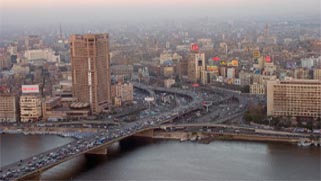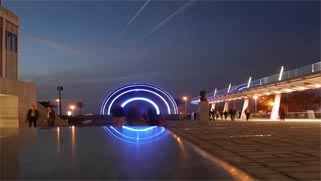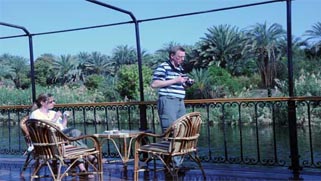|
|

| |
| |
Luxor Temple
By Seif Kamel |
| |
Located in the heart of the modern city of Luxor, the Luxor temple, especially the two colossi of Ramses II situated at the entrance of the temple, has become a land mark of the city.
The Luxor Temple is one of fine examples of the architecture of the Pharaohs. Being constructed, restored, and modified during different periods of the Pharaonic history, the Luxor Temple is a live demonstration of the architectural evolution taking place from one age to the other. The Luxor Temple is one of the major monuments of the city that is almost included in all tourists' itineraries. |
| |
| |
| |
|
| |
|
The original name of the Temple of Luxor |
|
| |
The temple of Luxor was
originally named "the southern Harem of Amun" in the
ancient Egyptian language as it was a major part of the
Karnak Temple and it was connected with it through the
famous avenue of sphinxes.
The temple of Luxor was the
house of a certain form of the god Amun which was called
"Amenemope" or Amun in the Opet and the god Amun of the
Karnak temple used to visit the Luxor temple once a year
during the Opet festival, a series of ceremonies with
the regeneration of the royal powers.
This was the
reason why the Luxor Temple was a very important
religious structure for the ancient Egyptians. |
 
|
| |
| |
| |
: |
The construction of the Luxor Temple |
|
| |
The Luxor Temple was
mainly built for the cult of the Theban divine triad;
the gods Amun, Mut, and Khonsu.
The major part of the
Luxor Temple was originally constructed by Amenophis III
who ruled Egypt for the period from 1387 to 1349 BC.
However, most of the buildings and structures we view in
the temple of Luxor today is attributed, the same as
many Pharaonic monuments in Egypt, to the Great king
Ramses II who ruled Egypt for a very long period
starting from 1279 to 1213 BC. Ramses II was able to
build a wide court in the Luxor temple and he added a
pylon to the great colonnade of the temple.
|
 
|
| |
|
|
The
description of the Luxor Temple |
|
| |
Ramses II has also added
his two huge colossi and two obelisks that were donated
by Mohamed Ali, the ruler of Egypt in 1830 to France.
However, only the western obelisk was actually taken to
France and reconstructed in Paris in 1836.
This
pylon built by Ramses II is decorated with reliefs
representing the battle of Qadesh, the greatest military
achievement of Ramses II when he was able to defeat the
Hittites and sign the first peace treaty between two
nations recognized in human history.
The triple shrine
dedicated to the divine triad; Amun, Mut, and Khonsu, is
located in the inner side of the west quay and it is
decorated with four fine papyrus shaped columns dating
to the reign of Queen Hatshepsut and which Ramses II has
largely restored.
After the divine triple shrine, the
guest views a huge courtyard that was built by Ramses II
and it was ornamented with 74 tall papyrus shaped
columns with huge statues of Ramses II constructed
between them. Ramses II is represented in these statues
as a symbol of royal power with his favorite wife,
Nefertari sculpted next to his knees. |
 
|
| |
| |
|
The Mosque of Abu Al Hagag |
|
| |
The great colonnade of
Ramses II is interrupted from the Eastern side with one
of the most interesting scenes one can see in any
Pharaonic monument. The guests visiting the Luxor Temple
will view an ancient mosque, built for Abu Al Hagag, A
Muslim preacher that lived in Luxor during the 13th
century, on top of the huge papyrus shaped columns built
by Ramses II.
When Gaston Maspero started his
excavation work to discover the Luxor Temple, which was
buried under many years of sand and dust to the extent
that a whole village was built on top of it, he had to
remove the entire village but for religious reasons he
had to keep the mosque of Abu Al Hagag as it is.
Many
years later during the 1990s, the Egyptian government
renovated the mosque and renewed its Eastern entrance.
The Abu Al Hagag Mosque is the only Moslem structure in
Egypt and in the whole world that contains Pharaonic
decorations and inscriptions. |
 
|
| |
| |
|
The
second Great colonnade of the Luxor Temple |
|
| |
At the end of the Great
colonnade of Ramses II, he constructed another two huge
colossal statues of himself that serve as if they are
the entrance to the second colonnade of the Luxor temple
that was built by Amenophis III.
This colonnade consists
of 19 papyrus shaped columns 19 meters each. The western
walls surrounding these columns are decorated with
scenes representing the Opet festival and dating back to
the reign of the famous king, Tut Ankh Amun who was the
youngest king to rule Egypt from 1333 to 1324 BC .
This
colonnade leads the guests to the solar court of Amenophis III and all this wide space was dedicated to
the performance of the rituals of the Opet Festival
where the barks of the three gods; Amun, Mut, and Khonsu
were worshiped before being transferred to the inner
part of the temple.
Then, the guests reach the
hypostyle hall of the temple consisting of 32 papyrus
shaped columns, which leads to the Roman sanctuary that
was established by the Roman Empror, Diocletian in the
3rd century BC.
An opening in the Roman walls leads
afterwards to the Shrine of Amun where the bark of the
god Amun was put. This sanctuary was rebuilt once again
by Alexander the Great (356 – 322 BC).
Another
hypostyle portico leads to the last section of the
Temple of Luxor that contains the sanctuary of Amun,
constructed by Amenophis III. This section was the home
of Amenemope, which was visited every year by the god
Amun of the Karnak Temple to regenerate together.
The
second part of this ceremony used to take place in the
birth room whose walls exhibit scenes representing the
divine union between the god Amun disguised as Tuthmosis
III and the Queen Mutemwiya
|
 
|
| |
| |
| |
 |
The
Karnak Temple
In ancient Egypt, the power of the god Amun of Thebes gradually increased during the early New Kingdom, and after the short persecution led by Akhenaten, it rose to its apex. In the reign of
Ramses III, |
 |
|
|
|
 |
The Valley of the Kings
The tombs of the
Valley of the Kings originally contained many other
items that were transferred to the Egyptian Museum
like the royal belongings of the king that he will
use in the afterlife |
 |
|
| |
 |
The Queen Hatshepsut Temple
In a spot sacred to the goddess Hathor in the West Bank of Luxor, situated under the foot of one of the huge Theban Mountains, the Queen Hatshepsut has built her mortuary temple that was so fascinating that was called many names in ancient times |
 |
|
| |
 |
The colossi of Memnon
The Colossi of Memnon. One of the main attractions on the West Bank of Luxor, a landmark which everyone passes on the road to the monument |
 |
|
| |
 |
The
Luxor Temple
Located in the heart of the modern city of Luxor, the Luxor temple, especially the two colossi of Ramses II situated at the entrance of the temple, has become a land mark of the city. |
 |
|
| |
|
 |
 |
 |
 |
 |
 |
 |
Discover Luxor
Do you have plans to travel to Egypt?
A comprehensive Egypt travel offer – of every type, destination and period in Egypt! In addition, |
Luxor Attractions
Luxor attractions and sightseeing attractions in
Luxor . Book Luxor attraction tours
with Select Egypt |
Luxor Holidays
special discount holiday packages offers for
Luxor travel. We give you tailor made holiday deals for
Luxor travel |
Luxor Tours & Excursions
special discount holiday packages offers for
Luxor excursions. We give you tailor made holiday deals for
Luxor travel |
| Read More >> |
Read More >> |
Read More >> |
Read More >> |
|
| |
 |
| |
 |
 |
 |
 |
 |
Luxor Hotels
Choose from over 89
Luxor hotels with huge savings. Whatever your budget, compare prices and read reviews for all our
Luxor hotels |
Luxor Map
Luxor was constructed on the ruins of the ancient city of Thebes, the capital of Egypt during the Pharaonic New Kingdom (1550 – 1069 BC). |
Luxor Monuments
The best monuments of
Luxor . Information about Luxor monuments, landmarks, historic buildings and museums in
Luxor |
| Read More >> |
Read More >> |
Read More >> |
|
| |
| |
|
|
|